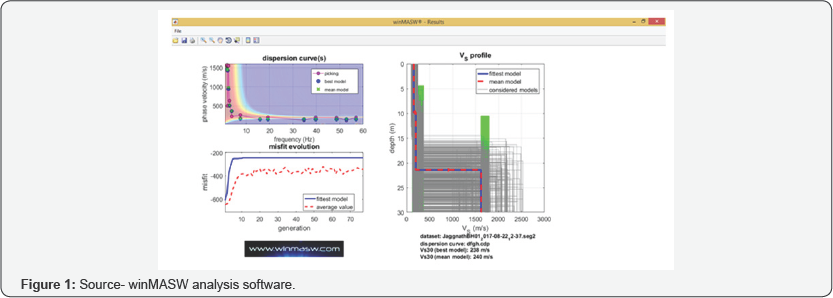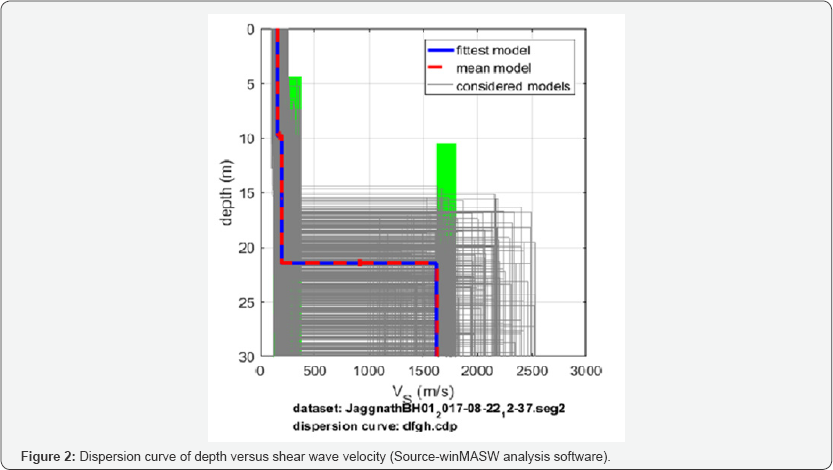Bearing Capacities of Backfilled Soil from Maswtest: a Quick and Convenient Methodology-Juniper Publishers
Juniper Publishers- Journal of Civil Engineering
Introduction
Soil characteristics through multichannel analysis of surface waves (Masw):
First introduced in GEOPHYSICS (1999), the
multichannel analysis of surface waves (MASW) method is one of the
popular seismic survey methods evaluating the elastic condition
(stiffness) of the ground for geotechnical engineering purposes
particularly for highly heterogeneous soil like mine backfill. The
demonstration of such a convenience is presented in t is short
article for the sake of information to the community. MASW first
measures seismic surface waves generated from various types of seismic
sources, such as sledge hammer or automatic drop hammer. It further
analyses the propagation velocities of those surface waves. Then finally
variations of shear-wave velocity (Vs) below the surveyed area are obtained. Shear-wave velocity (Vs) is one of the elastic constants and closely related to Young's modulus. Under most circumstances, (Vs)
is a direct indicator of the ground stiffness which is used to derive
load-bearing capacity. After a relatively simple procedure, final
information is provided in 1-D, 2-D, and 3-D formats.
MASW Test
The test was conducted at Jagannath colliery
(Talcher, Orissa, India, Latitude- 20o57’50.021”, Longitude-
85o07’57.021”) near a bore hole already the bearing capacity through
which have been tested. 24 Geophones were set across bore holeat a
distance of 1m apart from each other, 12 on either side of the borehole.
The last geophone was connected to a trigger and the signal is induced
to it by hammering. The other geophones were connected to the receivers
which pass on the acquired signals due to hammering, to the geophones.
The geophones then pass on the signals to the controller (installed in
laptop). This controller records the signals, analyses and generates
outputs accordingly. The acquisition was carried out in a compact-sized
24 channel seismograph with a 24 bit data acquisition board and USB
interface for external PC.
Analysis of the acquired data
The analysis after performing the test and
acquisition of the relevant data was carried out in the software winMASW
Version 7.2 which produced the following results (Figure 1 & 2).


(Vs) Profile (Enlarged)
After obtaining the shear wave velocity, the
elasticity modulus of the soil was obtained from appropriate formulae.
Further, the allowable bearing capacity of soil was obtained by an
indirect relationship utilizing the modulus of sub grade reaction of
soil. The adopted procedure is explained and enumerated as follows.
The density ofthe soil at Jagnnathpur site previously obtained was ρ 2610kg/m3 (obtained from specific gravity test). Hence density, =2610kg/m3, U =0.25. Further, from MASW dispersion curve, shear velocity (V) obtained at 3m depth is 155m/s. It is known that shear wave velocity  where G is the shear modulus. Hence, substituting the corresponding values the shear modulus is obtained as
where G is the shear modulus. Hence, substituting the corresponding values the shear modulus is obtained as . Further, modulus of elasticity is obtained as
. Further, modulus of elasticity is obtained as
 where G is the shear modulus. Hence, substituting the corresponding values the shear modulus is obtained as
where G is the shear modulus. Hence, substituting the corresponding values the shear modulus is obtained as . Further, modulus of elasticity is obtained as
. Further, modulus of elasticity is obtained as
From the following equation [1], modulus of sub grad  Again, from the same literature [1], another empirical relation between modulus of sub grade reaction and allowable bearing capacity can be obtained as
Again, from the same literature [1], another empirical relation between modulus of sub grade reaction and allowable bearing capacity can be obtained as
 Again, from the same literature [1], another empirical relation between modulus of sub grade reaction and allowable bearing capacity can be obtained as
Again, from the same literature [1], another empirical relation between modulus of sub grade reaction and allowable bearing capacity can be obtained as
From the above equation, considering a Factor of Safety (F.O.S) of 3 the allowable bearing capacity is obtained as  . On the other hand, the SPT test conducted in this region produced an
SPT value of . As the width of footing > 4ft, allowable bearing
capacity can be given by the equation as follows [2].
. On the other hand, the SPT test conducted in this region produced an
SPT value of . As the width of footing > 4ft, allowable bearing
capacity can be given by the equation as follows [2].
 . On the other hand, the SPT test conducted in this region produced an
SPT value of . As the width of footing > 4ft, allowable bearing
capacity can be given by the equation as follows [2].
. On the other hand, the SPT test conducted in this region produced an
SPT value of . As the width of footing > 4ft, allowable bearing
capacity can be given by the equation as follows [2]. where
is the depth from ground level to bottom of the footing in feet; is the
width of footing in feet. Hence, substituting the corresponding
numerical values, =1+0.33(9.84/32.81) which gives the value as 1.10 and
the allowable bearing capacity is obtained as
where
is the depth from ground level to bottom of the footing in feet; is the
width of footing in feet. Hence, substituting the corresponding
numerical values, =1+0.33(9.84/32.81) which gives the value as 1.10 and
the allowable bearing capacity is obtained as 
Conclusion
Comparing the bearing capacities obtained from SPT
test and MASW analysis of Jagannath colliery it can be inferred that
they are more or less close to each other (16.18t/m2 and 13.93t/m2)
which ascertains the accuracy of the tests. Further, conducting test by
MASW is less hazardous as no digging or previous preparation is needed
and the test can be carried out more quickly at more than one places
within a day. Thus, it may be extremely helpful for deciding the
characteristics of heterogeneous soil.
Acknowledgement
The present article is a small part of the activity of Coal S&T project bearing a number EE46 sanctioned by Ministry of Coal, Government of India. Financial support rendered by them for MASW is greatly acknowledged.
For More Open Access Journals Please Click on: Juniper Publishers
Fore More Articles Please Visit: Civil Engineering Research Journal
Fore More Articles Please Visit: Civil Engineering Research Journal

Comments
Post a Comment